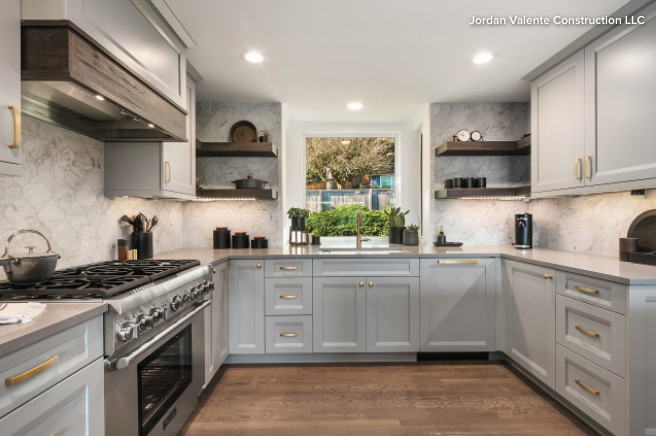
If you’re remodeling your kitchen or designing a new one, your first order of business is choosing a layout. Do you want open or closed concept? Does the standard work triangle best suit your cooking style, or will work zones make food prep and cleanup more efficient for you? Do you want a design with storage room to spare? Only you can answer these questions, but one thing is clear: Your layout determines the way you cook, socialize and entertain. Here’s the skinny on three common layouts to help you pick a winner.
U-Shaped
U-shaped kitchens are more common in older homes and smaller residences (such as apartments and townhomes), but you can also find them in modern builds.
Pros: U-shaped kitchens utilize three walls or cabinet sections, so you’ll probably have good storage space relative to the size of your kitchen. Since your appliances will be closer together (especially in smaller kitchens), you won’t have to walk to the other side of your kitchen for food prep or cleanup. Last, some homeowners prefer closed kitchen designs, and a U-shaped design will keep the space separate from living and dining areas.
Cons: U-shaped kitchens often feel cramped because of how close your appliances are located to one another. As a result, you may not have enough room to operate during meal prep, and cooking may not be a functional process for you. Cabinetry isn’t always easy to access due to corners. An island is usually out of the question. Yes, some homeowners prefer closed-off kitchen spaces, but many homebuyers want an open-concept design, especially in today’s housing market. Many U-shaped kitchens can feel isolated from the rest of your home’s living space. Large designs will have a spread-out work triangle, which can be an inconvenience.
If you’re looking for ways to turn your U-shaped kitchen into an open-concept design, knocking down a wall can do just that. You can create a peninsula with bar-style seating once the wall is removed and then feel connected to adjacent spaces.
You may also be able to knock down two of your existing walls or design a U-shaped kitchen with only one full-height wall. This contemporary kitchen offers a fully functional cooking space that’s also well-equipped for entertaining.
Some U-shaped kitchens are large enough to host an island. Walkways between cabinetry must be at least 36 inches wide, so one of your kitchen walls must span at least 12 feet to fit a 24-inch deep island.
L-Shaped
These types of kitchen layouts use two walls or sections of cabinetry, forming an L. They usually include an island in the middle.
Pros: L-shaped kitchens provide the consummate open-concept cooking experience. They’re ideal for entertaining and socializing, and can transform your kitchen into the true hub of the home. If we take layouts at face value, L-shaped kitchens are the most island-friendly layout because of how spacious they are. They have sufficient counter and storage space when they include an island. You can also better opt for work zones instead of the traditional work triangle in L-shaped kitchens.
Cons: You almost always need an island to ensure that you have enough workspace. This added expense may not suit your budget. An island may not suit your cooking style either. The work triangle is more spread out in L-shaped kitchens. While some homeowners appreciate the space, others will grow tired of walking back and forth between their stove, sink and refrigerator. There’s usually more to clean. L-shaped kitchens often require more finishing material, and they can carry a higher price tag than galley kitchens and small U-shaped kitchens.
Galley
A galley kitchen has one pass-through between two sections of cabinetry. These sections may be composed of closed walls, partially open walls or an island.
Pros: Galley kitchens maximize space and make for efficient cooking zones. Your appliances are organized and easily accessible. They offer versatility to homeowners. They can be open or closed concept. They can take advantage of limited space you may already have or save space when you’re designing a new home. Galley kitchens tend to be smaller; you won’t have to spend a fortune on finishing materials like cabinets, countertops and backsplashes, nor will you spend a lot of time cleaning up. Cabinetry is fully functional and accessible.
Cons: On the flip side, the smaller size can be a drawback. If you want a supersize kitchen with ample storage and counter space, you may not find a galley design sufficient. Particularly, upper cabinetry can be limited in some designs. If you’re designing a new home and considering a galley kitchen, you may not have room to expand 10 years down the road.
A more modern rendition of the galley kitchen features one wall of cabinetry with an island. This type of galley kitchen is your best bet for an open-concept design.

It’s your special day – you’re investing in a kitchen upgrade! The average homeowner will perform a big remodeling project like this maybe once or twice in a lifetime. With this in mind, you’ll want to make sure to get the best return on investment.
A quartz countertop can maximize that upgrade project for durability, style, and value, and there are many other reasons that keep these kitchen countertops in high demand.
One reason to fall in love with quartz is the wide range of colors to choose from. As a manufactured material, quartz’s color and patterning are controlled by the various crystals and pigments used in the process. Quartz colors range from pure white to jet black along with shades of red, gold, blue, and more.
Quartz also can be made to resemble natural materials such as granite or marble. Calacatta Verona Quartz is a great example of this, with realistic marble-like gray veining on a white surface. With quartz you can have the beauty of marble without the maintenance and worry – what a great value.
Nature lovers will appreciate the eco-friendly qualities of a quartz countertops. For one thing, unlike natural stones which are quarried and imported from all over the earth (along with transportation costs and fuel consumption), quartz is produced using local materials and is easier to transport.
Natural stone countertops need to be sealed, and quartz does not; this eliminates the need for chemical sealers. Also, some of our Q Premium Natural Quartz Countertops are made with up to 35% post-consumer recycled glass. Have your beautiful countertops – such as the pebbly, nature-inspired Toasted Almond — and feel good about them, too.
Even the most eco-friendly material is impractical unless it is made to last a long time, and a quartz countertop certainly fits this description.
Since it will last for decades, consider installing a classic neutral such as Fossil Brown – you can change your kitchen cabinetry and décor a dozen times during your quartz countertop’s lifetime, and it will still look great!
Perhaps the most popular reason to choose a quartz countertop, however, is its simple care requirements. There’s no need to seal quartz countertops, unlike natural stone. Quartz countertops are waterproof, extremely stain resistant, and stand up to heavy use.
With Quartz you can feel confident choosing white quartz countertops such as Iced White Quartz or Frost White Quartz without worrying about stains. It’s easy to keep a quartz countertop pristine and hygienic, free of dirt and bacteria.
If you thought quartz was just a trend, think again! These manufactured surfaces have been popular in kitchens and bathrooms for over 20 years now, and are definitely here to stay. You can be confident that your quartz countertop investment will pay off in terms of resale value – and you will love it too.
Visit our online inventory to see the newest slab colors, and enjoy planning your kitchen upgrade.
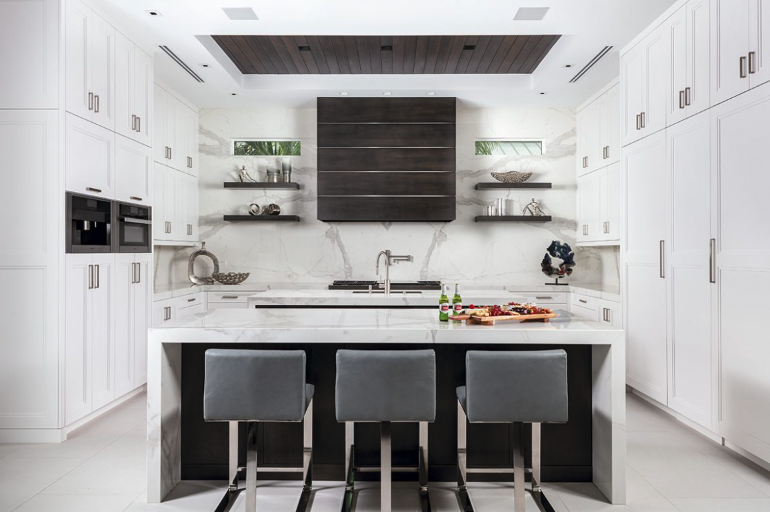
Changing lifestyles, emerging design trends and consumer product “hot buttons” are having a major impact on materials, colors and styles for countertops, which continue to grow in prominence as both an aesthetic and functional feature in today’s new and remodeled kitchens.
That’s one of several key findings of a nationwide survey conducted by Kitchen & Bath Design News among kitchen dealers and designers, who report that countertops – impacted largely by the COVID-19 pandemic – have increasingly become the focal point of the modern-day kitchen, serving not only in their traditional roles of food prep, eating, cleanup and entertaining, but as a multi-purpose space for homework, hobbies, work-from-home projects, and various other activities.
Yet despite the dizzying array of colors, materials, features and other choices available, kitchen consumers are very specific when it comes to the criteria they consider when selecting their countertops, the KBDN survey found.
According to the findings of the survey, conducted last month, key factors in countertop selection include material, color, durability, affordability and sustainability. Sanitary benefits have also become increasingly important, dealers and designers tell KBDN. Similarly, cost is also a factor in homeowners’ selection of a countertop material, although it seems that clients are increasingly willing to invest – and even stretch their budget – in order to obtain the material, functionality and overall aesthetic they desire.
According to the survey’s results, engineered quartz continues to be the countertop material that dealers and designers report is growing fastest in demand among their kitchen clients.
Specifically, the KBDN survey found that engineered quartz countertops are seen by nearly 33% of those surveyed as the countertop they see growing fastest in demand (see Figure 1).
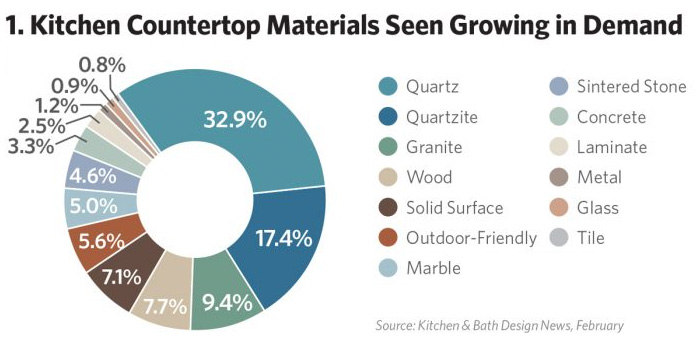
By comparison, quartzite – natural sandstone that is fused under heat and pressure with sparkly quartz crystals – is viewed as the fastest-growing kitchen countertop material by roughly 17% of survey respondents, while granite is seen as fastest-growing among just over 9% of the design professionals polled. Other countertop choices include solid surface (7%), marble (5%), sintered stone (4.6%) and concrete (3.3%). Outdoor-friendly surfaces are also seen as increasing in popularity, along with the growing trend toward outdoor living.
In terms of color, white/cream (45%) and gray (24.4%) are the predominant colors in demand, according to survey respondents. Black is preferred by about 12.6% of the designers’ clients. Shiny and matte surfaces are preferred about equally by their customers, surveyed design pros report (see Figure 2).
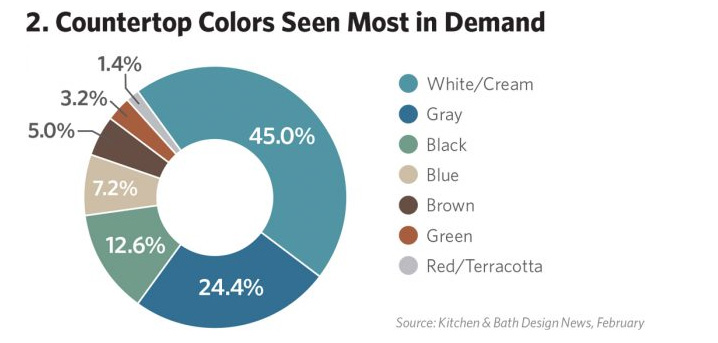
Dealers and designers also report that clients are increasingly gravitating to countertops that feature subtle patterns and movement, as opposed to other options. The KBDN survey found, for example, that 62.5% of the dealers and designers polled reported that countertops with subtle patterns were the preference of clients. In contrast, only 18.8% said their clients are gravitating toward marble-look surfaces, while 12.5% said their clients prefer countertops with dramatic patterns or movement, and 6.3% said clients are gravitating toward solid-color tops.
The importance of selecting countertops with distinct sanitary/health benefits has apparently become increasingly important to clients, doubtless as a result of increased awareness regarding the benefits of anti-microbial protection due to the COVID-19 pandemic.
For example, some 55% of their customers consider sanitary benefits such as easy-to-clean and anti-microbial protection to be either “very important” (42%) or “extremely important” (13.2%), according to surveyed dealers and designers. At the same time, surveyed design pros say sanitary benefits are “moderately important” to some 24% of their clients. By comparison, only about 20% of their customers consider sanitary benefits to be only “slightly important” (18.3%) or “not at all important” (1.9%), survey respondents report (see Figure 3).
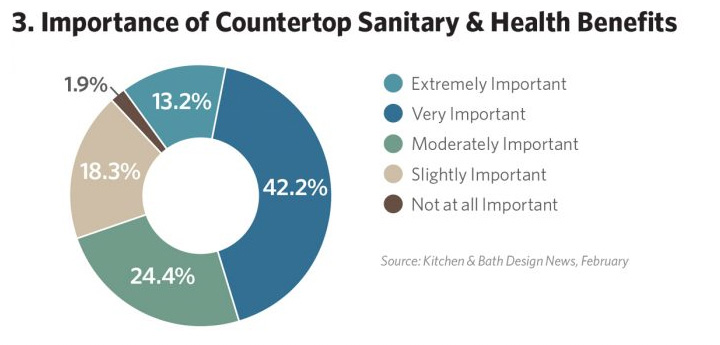
Durability also remains an important factor in countertop material selection, with some 55% of the surveyed dealers and designers saying durability is “very important” to clients, and roughly 37% saying durability is “extremely important.” In contrast, only about 1.3% of clients feel countertop durability is “not at all” important (see Figure 4).
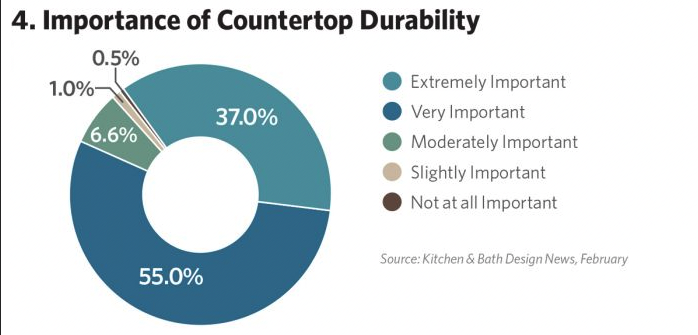
Affordability, as noted earlier, is somewhat less of a factor in countertop selection.
The KBDN survey found, for example, that only about 36% of their customers consider affordability to be either “extremely” important (8.5%) or “very” important” (25%), survey respondents said. By comparison, however, some 56% of dealers’ and designers’ customers said affordability was only “moderately” important, while more than 10% said it was either only “slightly” important (8%) or “not important at all” (2.4%) (see Figure 5).
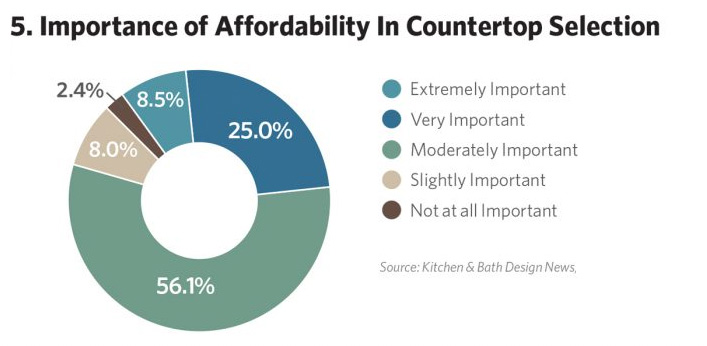
PALO ALTO, CA — Homeowners are making room in their kitchen remodeling budget to prioritize large, multi-functional countertops, in part as a response to the impact of the COVID-19 pandemic on American lifestyles, a major new study has found.
According to the 2022 U.S. Houzz Kitchen Trends Study, more than one-third of surveyed homeowners (35%) reportedly “splurged” on countertops, which were upgraded by more than nine in 10 homeowners, the most common feature improved during kitchen renovations.
“It’s clear that homeowners are willing to spend a little more to get exactly what they want in countertops that are both beautiful and practical, despite rising prices of labor, products and materials,” said Marine Sargsyan, senior economist for the Palo Alto, CA-based online platform for home renovation and design.
When it comes to choosing new kitchen countertops, homeowners opt for materials based on the look and feel, durability and ease of cleaning, rather than cost, said Houzz, whose online survey was conducted among nearly 2,400 U.S. Houzz users who are in the midst of, are planning or recently completed a kitchen renovation.
Engineered quartz and granite are the most popular countertop materials (42% and 24%, respectively), despite tariff and pandemic-induced price increases, Houzz reported. Of the more than one in five renovating homeowners who select an island countertop material that contrasts from their primary countertops, over one-third choose butcher block or wood slab. Aesthetically, homeowners increasingly choose white for their countertops during renovations.
Among other survey findings:
sponsored by kitchenbathdesign.com
If you want to cut down on the time it takes to keep your kitchen spick and span, you should take a closer look at your finishes. From flooring to hardware, the materials you select can tack on extra time to your cleanup routine. Wondering which options cut down on dusting, scrubbing and wiping? Here’s a list of easy-to-maintain finishes.
Flooring
1. Ceramic and porcelain tile. Kitchens are both wet zones and high-traffic areas, so proper flooring material is key. Ceramic and porcelain tile have moisture resistance that is superior to natural stone or wood (especially porcelain, which absorbs less than 0.5% of moisture when wet). They’re also highly resistant to scratching and staining. Unlike natural stone, you don’t have to seal ceramic and porcelain tile. They also don’t require special cleaners and can handle almost any type of sanitizing agent.
2. Vinyl. Whether it’s planks or traditional sheets, vinyl is well-equipped to handle your kitchen’s worst. Unlike laminate and hardwood, vinyl can handle moisture with relative ease. Its PVC veneer and backing protect against spills and leaks. It’s tough to scratch and stain, and like tile, vinyl cleanup is quick and easy. Water and a mop will remedy the majority of messes. No grout lines is a huge perk, too.
Cabinets
1. Flat-panel doors. Even if you’re not a fan of modern design, it’s worth considering flat-panel doors if your top priority is easy upkeep. The less door detail, the less dust and dirt. Flat panel doors are also easier to wipe down because their surface doesn’t have recesses or raised grooves.
2. Shaker doors. If flat-panel cabinet doors are just too modern or you aren’t sure if they match your kitchen’s style, Shaker door fronts are a good compromise. They add a touch of detail but are still relatively easy to clean.
Medium-Tone Stains
Dark paints and stains show dust particles and fingerprints. White cabinets don’t, but they show just about everything else. While medium-tone stains aren’t immune to wear and tear, they’ll show significantly less mess. They’re also easier to touch up than paints. Choose a wood species that features grains and grooves to help hide stains and scratches. Oak, quarter-sawn oak, hickory and beech are smart options.
Quartz Countertops
This engineered product is one tough cookie. It isn’t foolproof, but it’s about as resistant to scratches and stains as countertops get. You only need a soft cloth and warm water for post-meal cleanup. If you have dried-on stains, quartz will hold up well to common cleaning products like Windex, Clorox and Lysol. The things to avoid? Corrosive chemicals and setting hot pans directly on its surface.
Stainless Steel Appliances
This staple material isn’t without fault. Stainless steel sinks, for instance, can develop a chalky residue around the drain due to hard water. They can also scratch. But overall, they’re highly durable and fairly easy to clean. Black and white appliances can face the same maintenance concerns as light and dark cabinetry.
Satin Paint for Walls and Cabinets
What’s the best low-maintenance paint type for walls and cabinets? It’s a tricky question. In a vacuum, the answer is high-gloss and semigloss paints. But when it comes to painting walls and cabinets, glossy paints can look too shiny and reflect too much light. Therefore, satin paints might be your best bet for easy upkeep and design integrity. They’re not as loud as high-gloss paints, are less porous than flat paints and are still very durable over time. Just be sure to hire a talented painter — satin paints can show brush and roller marks more easily than other types of paint.
Semigloss Paint for Trims and Baseboards
Semigloss paint handles moisture, stains and bumps and bruises exceptionally well, so it’s an obvious choice for kitchens. Wall trims and baseboards are common applications for semigloss paint. You don’t have to worry about sacrificing aesthetics for maintenance.
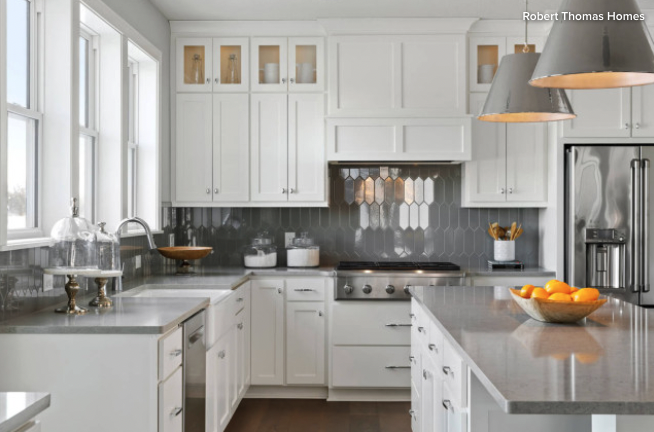
Backsplashes
1. Ceramic and porcelain. Like their flooring counterparts, ceramic and porcelain tile backsplashes are virtually maintenance-free. Most options feature a protective glaze that resists stains and doesn’t require any sealing (there are exceptions, of course). These two nonporous materials excel at water resistance, too.
2. Glass. Though glass backsplashes are more likely to show grease and food splatters than ceramic and natural stone, they’re super easy to wipe down thanks to a smooth surface finish. You can also ditch grout lines altogether with solid-glass sheets.
written by Sam Ferris

Unlike synthetic countertops, granite is created by nature. Each granite slab has unique fissures, swirls, and flecks of shiny iron bits. There may be 10 slabs at a showroom—all from the same quarry—with wildly varying characteristics. If you have a granite countertop in your kitchen, you know you have a piece that is truly one-of-a-kind.
Quality kitchen elements like granite counters make your space look more high-end and updated. Granite counters attract potential buyers, as they know they’re getting something they won’t have to update when they move in. The more turnkey a home is, the higher its value will be.
Different countertops have different prices, care requirements, and durability. Granite has a very high hardness rating. This means it can stand up to scratches and accidents better than other options (especially marble). For active families and busy kitchens, this is an exceptionally valuable feature.
When considering natural stone versus synthetic stone countertops, natural stones like granite are the more sustainable option. This is because they require minimal processing before they make it to your kitchen. Synthetic materials call for a lengthier and more complex production process, which may include toxic chemicals and releasing harmful emissions into the atmosphere.
Though granite countertops are highly resilient, accidents happen. Luckily, even if your granite counters get cracked or chipped, they are usually repairable. A countertop repair pro near you can often use filler materials to get your granite looking good-as-new again. If a heavy pot slips from your hands, or if a glass jar falls from your cabinet, it’s nice to have that extra peace of mind.
When choosing the right countertop, you can’t go by looks alone. You’ll also need to consider how well it’ll hold up against spaghetti sauce, red wine, or other spills. It’s also important that countertops don’t absorb all the icky germs and bacteria from raw meat during meal prep. Provided they get sealed properly at least once a year, your granite counters will wipe clean of all these messes.
Since granite gets formed naturally via pressure and heat, granite counters have built-in heat resistance. While it’s still a good idea to use potholders, you won’t have to worry about the scorching you’d get with other countertop varieties. Get in touch with a top-rated countertop installer near you to learn more.
If you’re shopping for natural stone countertops, you’ve probably considered granite and quartz varieties. While both of these stones are extremely durable, the biggest difference between quartz and granite is that granite stays true to its color the longest. Quartz can become discolored over time if left in direct sunlight. If you have a skylight in your kitchen, or just a lot of natural sun coming in, this is definitely something to think about.
In addition to choosing the best material, mounting type, number of bowls and bowl depth for your kitchen sink, you also have a range of sink size options. An extra-wide kitchen sink will obviously give you more space for food prep and cleanup, and you might prefer it over the confines of a smaller sink, but bigger sinks typically cost more and can take up valuable real estate in a small kitchen.
Feeling overwhelmed? Don’t worry. We’ve pulled together kitchens that feature various sink sizes, along with tips to help you figure out the perfect sink size for your cooking and cleaning needs.
1. Size Your Sink to Your Kitchen
It may seem obvious, but if your kitchen is on the smaller side, consider installing a smaller-width sink. An oversize, triple-bowl model would have overwhelmed this charming but compact loft kitchen. The more modest-size, yet still deep, the single-bowl apron-front sink is large enough to accommodate most kitchen tasks, but it isn’t a space hog. Countertop and base cabinet storage areas are likely to be at a premium in a smaller kitchen, so a smaller-width sink will improve overall function too.
2. Size Your Sink to the Window Above It
Homeowners often install a kitchen sink beneath a window, preferably a window with a nice view. But some homeowners overlook how these two elements work together. That’s not to say your sink and window need to match widths exactly, but it can look odd to have a super-wide sink set below a skinny window and vice versa.
3. Size Your Sink to Be a Focal Point
If you choose to go with an extra-wide sink, you’re going to have a difficult time disguising it. My advice is to take the opposite approach and make your wide sink a focal point. Repurpose an interesting salvaged sink or consider an unusual material, like copper.
4. Size Your Sink to Your Budget
This might also be obvious, but it’s all too easy to fall in love with a huge, gorgeous, apron-front sink only to find that it’s priced well above what your budget will allow.
Installing all top-of-the-line materials, fixtures and appliances in a kitchen doesn’t make sense for everyone, so it’s helpful to strategize on where you’re going to spend money and where you can save.
Personally, I’d rather splurge on my countertops or kitchen floor than the sink. After all, you can get a perfectly good 20-inch-wide stainless steel undermount sink for less than $200.
5. Size Your Sink Based on Your Needs
If you’re an avid cook who prefers hand-washing dishes to running the dishwasher, a large divided-bowl sink with an integrated drainboard is a great option. The wider sink allows multiple people to work at the sink without getting in each other’s way, and that built-in drainboard makes the business of draining and air drying dishes less of a wet mess.
A sink this size will require an extra-wide sink cabinet and will take up quite a bit of space, so it’s best for a generous-size kitchen.
If you need a hand with prepping meals or cleaning up, consider installing two single-bowl sinks instead of one extra-large sink. A configuration like this allows two cooks to work together, and because these sinks are set apart, traffic jams are less likely.
If you have the space and budget for it, a three-sink setup is nice for a multicook household that does a lot of entertaining. The separate sinks allow several people to work in the kitchen simultaneously. None of the sinks needs to be exceptionally large. One main sink can handle bigger tasks and the others can be sized much smaller. Of course, this configuration has the potential to be costly due to the duplicate plumbing fixtures and installation fees.
6. Consider Fun-Size Sinks
I love these linear sinks. While it’d be difficult to wash dishes in one, they work just fine for fetching a glass of water or dumping out abandoned drinks when the party’s over. You can also fill one with ice and stash cold drinks in it, a nice alternative to keeping an unsightly cooler in the kitchen or having guests rummage through your refrigerator for a cold one. And it doesn’t take up much space on the countertop.
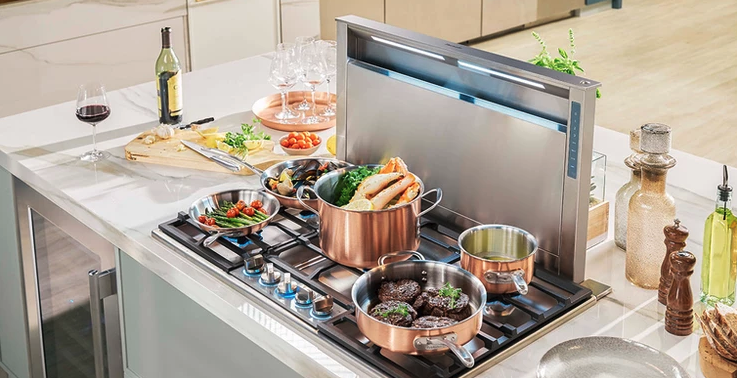
More Than 60% of Renovated Kitchens Feature Islands (2020)
According to Houzz’s survey, kitchen islands continue to be very popular for eating (58%), entertaining (49%) and socializing (45%). If your house has the space to add an island, there are so many features that can add storage, style, better line-of-sight, and new appliances. Since a kitchen is one of the most complicated spaces to design in a house, you need to decide what your island’s main function will be. Most islands have one side for cooking and the other side is devoted to eating, but what will your emphasis be? Prep work, cooking, cleaning, eating or entertaining? Or will you use it for everything, including homework and house projects? A well-planned island layout can allow a smooth workflow and provide a comfortable space for preparing and cooking food. There are many possibilities for making an island work, even where space is limited. An island work area allows you to face guests or family members while you prep or feel connected to people in adjacent rooms if you have an open floor plan.
Hiring a kitchen designer is a must to ensure it flows well and all the cabinets fit together in the required space. The busy nature of the kitchen space requires every part to be cohesively designed. Your designer will also ensure that the kitchen has the right amount of clearance between the island and the opposing cabinets and appliances, so that all doors, drawers, ovens and dishwashers can be opened safely and without obstruction. Careful planning is the key to achieving an efficient island that will enhance the use of your space. Most kitchen designers can also offer options with a reduced depth, a customized height or extra-large cabinets tailored to suit a specific design and the space it is intended for.
When decorating a kitchen or dining area, one of the most impactful decisions you would make would be your choice of a kitchen island or bar counter. A kitchen island greatly expands the available surface area that you get to work with, while a bar counter provides you with an additional preparation surface along with a serving surface for your guests.
Let’s dive deeper into some of the key differences between having a kitchen island or a bar counter:
Kitchen Island
Kitchen islands are typically placed in the middle of kitchens, surrounded by cooking stations to provide the cook with a convenient space to place raw ingredients, ready dishes, or mixing bowls. Because they tend to have a larger surface area, they are ideal for big kitchens or intensive baking operations that call for many ingredients. Many kitchen islands also come with storage solutions, providing additional space for you to store your cookware.
Bar Counter
Bar counters are typically located on the edge of the kitchen, adjacent to a living area or dining area, depending on the home layout. With a lower and higher surface, the lower surface is typically facing inward to the kitchen for the host to mix drinks or place the finishing touches on dishes before serving their guests on the other side of the bar counter. When combined with appropriate bar stools, they also provide additional space for cosy conversation in a relaxed yet classy atmosphere.
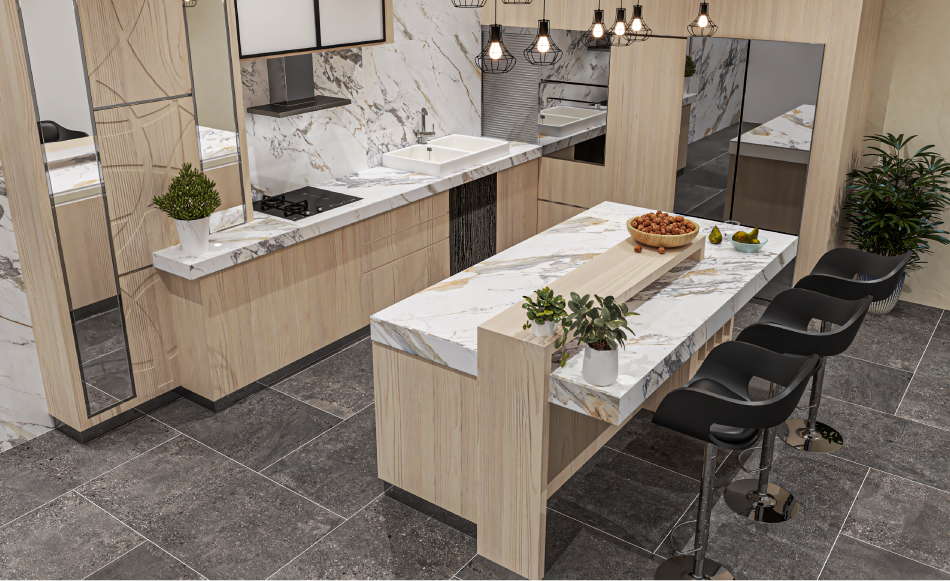
For kitchens that have a brighter outlook or light wood accents such as sandalwood or elm, going with light colors on the countertop is a great way to keep with the color theme while maintaining the airy and open feeling that the light shades afford.

For an elegant and dramatic look and feel, a glossy black countertop does just what you need. The deep shade of black is a great complement for darker décor, and when paired well, can yield a very satisfying and even cosy atmosphere.
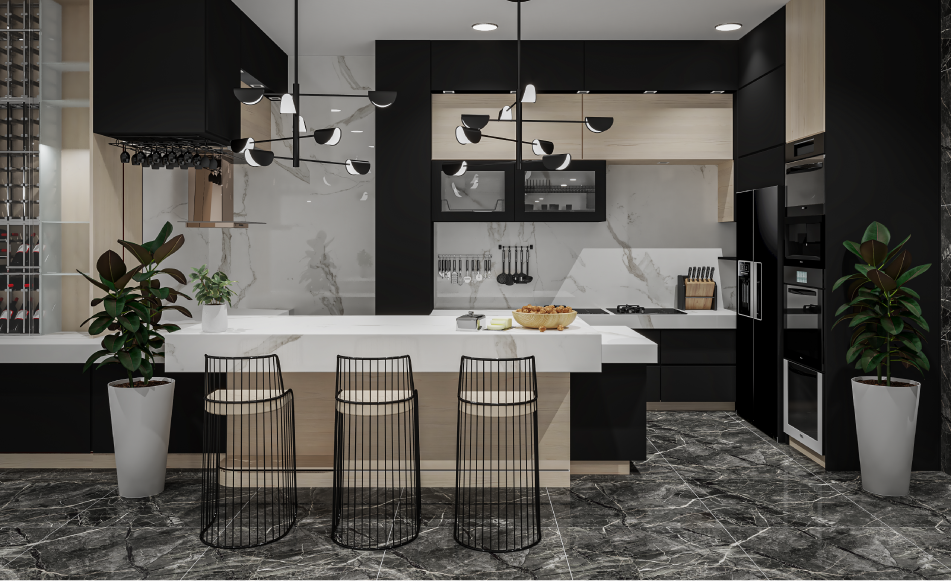
There’s no denying the appeal of the classic marble look, which is effortlessly elegant and ever so easy to love. The traditional look of marble especially goes great when paired in contrast with black surfaces, creating a space that is definitely worthy of envy.
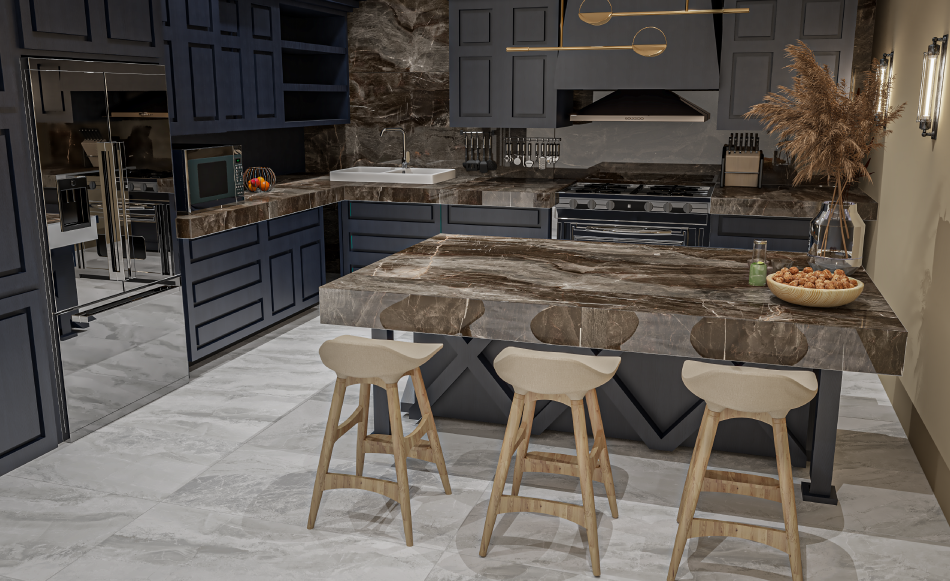
When you want something that’s not all black or white, going with a glossy grey is also a good way to add depth to color without darkening a space too much. What’s more, grey tends to work great with navy and brown, if you should desire to include those colors as part of your décor.
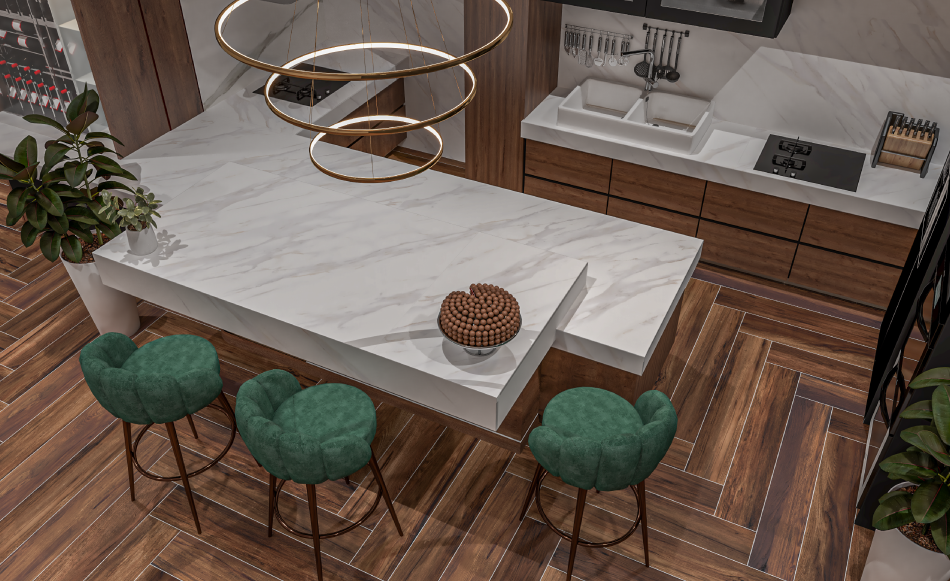
The pristine surface of white marble has been a favorite among many going back hundreds of years, and it’s easy to see why! Not only does it look and feel clean, but it also helps brighten up any space and gives everything in its vicinity a wonderful glow.
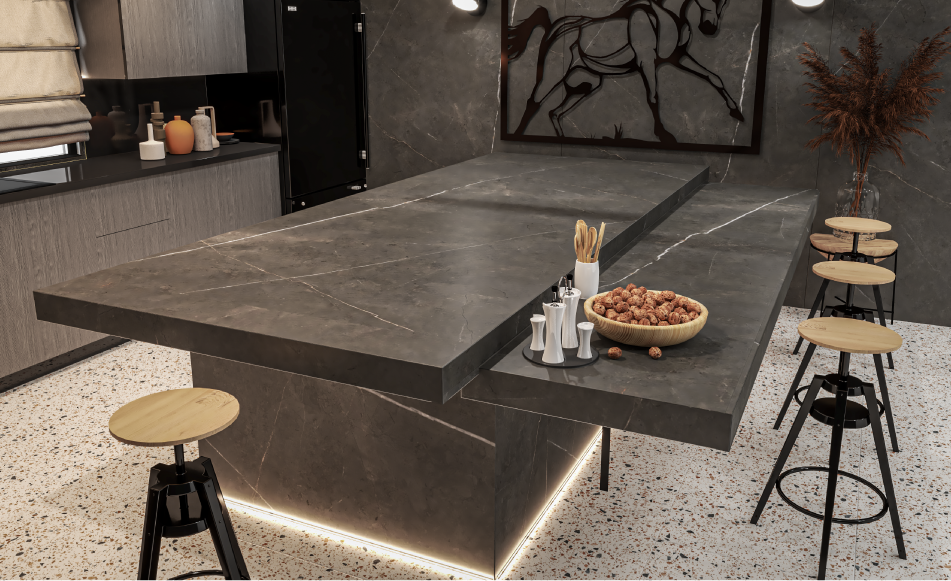
Of course, the understated look of a dark–honed surface also has its unique allure – as honed surfaces tend to absorb rather than reflect light, strong lighting is a good complement for these dark surfaces, which helps the colorful elements stand out all the more.

In the debate over how to make this feature more functional, consider more than one side
Don’t let a good visual get in the way of functionality. Before you renovate or give your island an update, consider these options for how to choose the best dining arrangement to save your household — and your knees — a lot of bumps down the road.
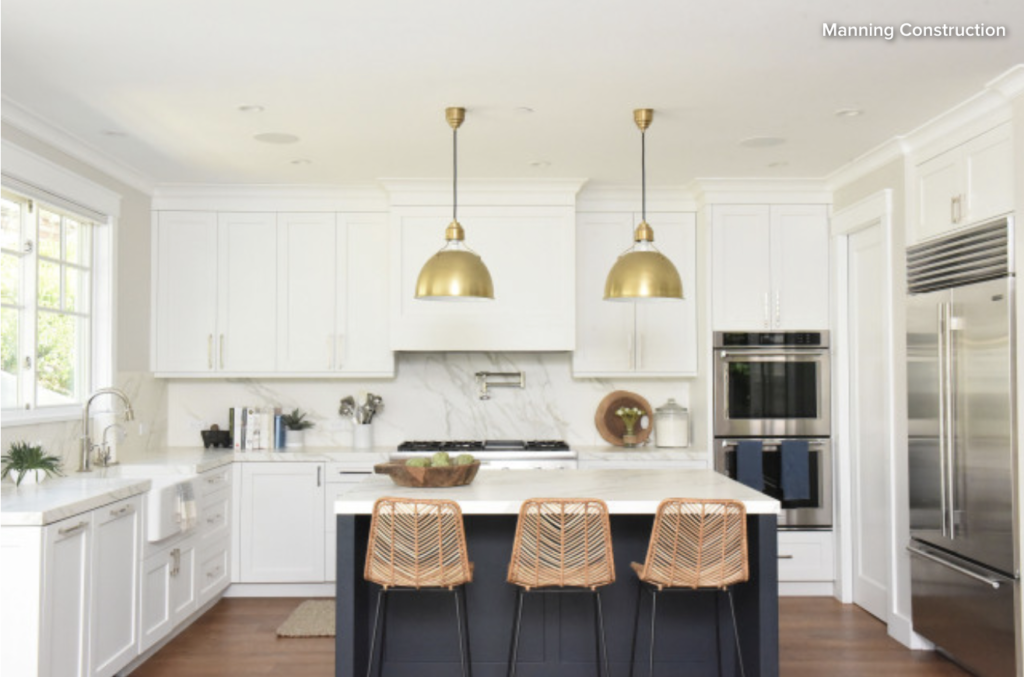
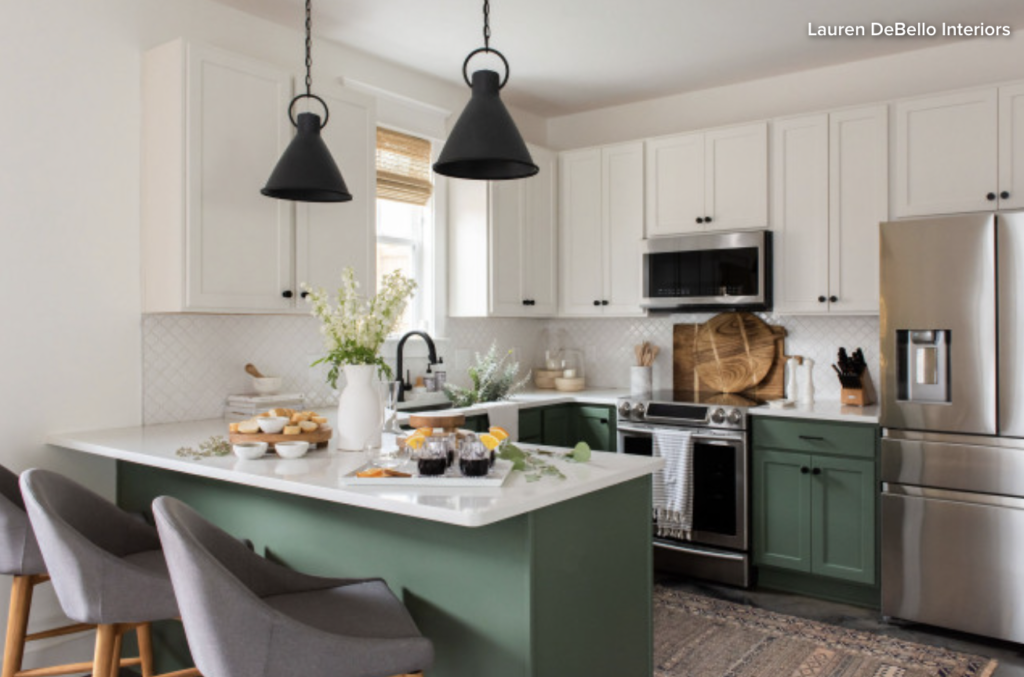
This arrangement works fine when just one or a few guests will be perched, chatting with the chef, or for a small household where most meals involve just one or two people. If the island isn’t expected to be used for larger groups than that, it makes sense not to dedicate any more space to seating.
If you don’t have room or a need for seats on more than one side, go the simple one-side route — just keep in mind that some factors will affect how comfortably guests can sit.
If your island has sides or legs that the seats sit between, as shown here, they might cut into the legroom.
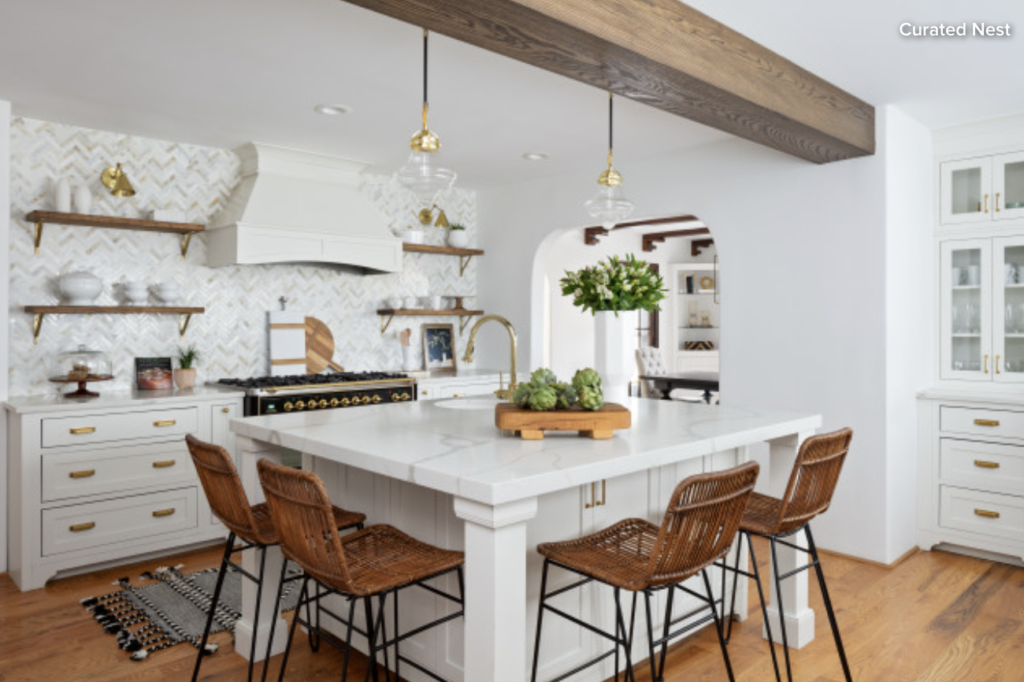
Two-Side Seating: Adjacent Sides
Adding seats to even just one adjacent side can go a long way to making your island a much more inviting spot to dine. By extending the island overhang to two sides instead of just one, you allow guests to sit facing each other.
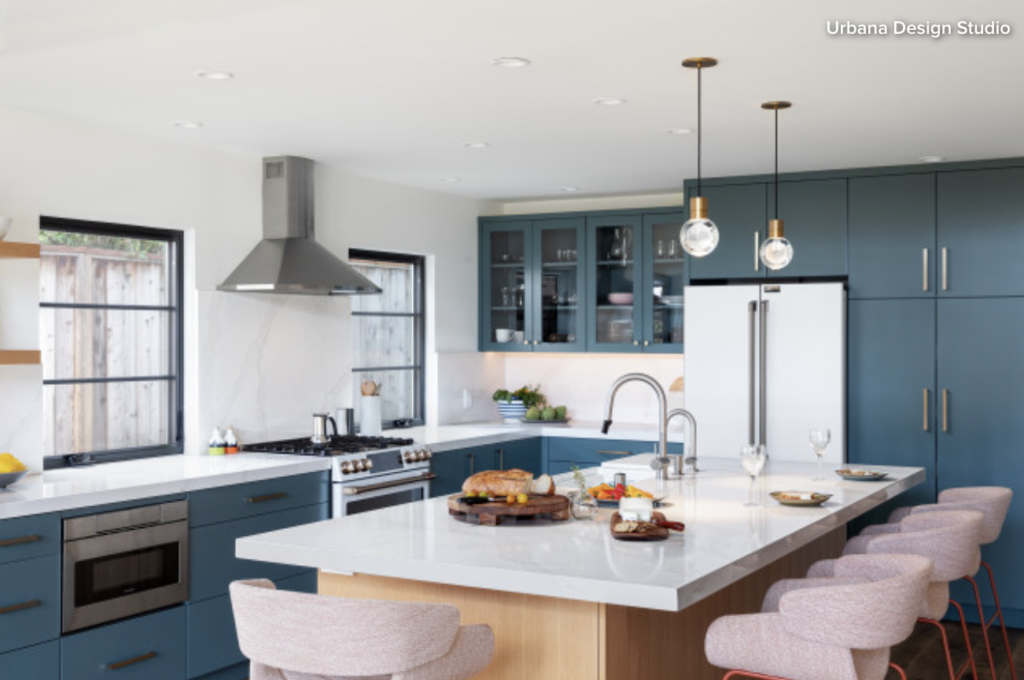
You can keep seats on both sides at all times, or save space by keeping seats on just one side most of the time and pulling a seat over to the available shorter side when needed.

This can be a great compromise where the floor plan doesn’t leave a lot of room for seating. By extending the overhang a few inches on the short side, you allow it to be used as a dining spot in a pinch, without losing too much storage or circulation space.
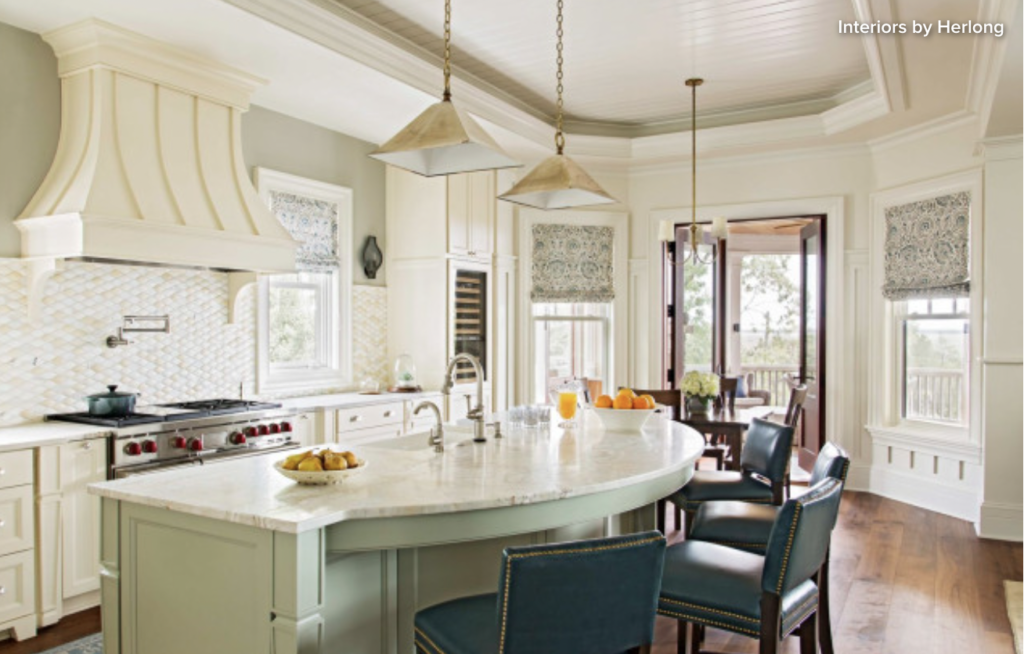
If you use a rounded corner like this one, you can effectively get three directions of seats from just two sides of the island, for a dining experience that’s even closer to sitting at a regular table.

Two-Side Seating: Opposite Sides
If your kitchen is long and skinny, it may make more sense to have a long, thin island, with seating on two opposite sides. This means guests can face each other, although if the island is quite narrow, you may not have much room to fit place settings as well as serving dishes.
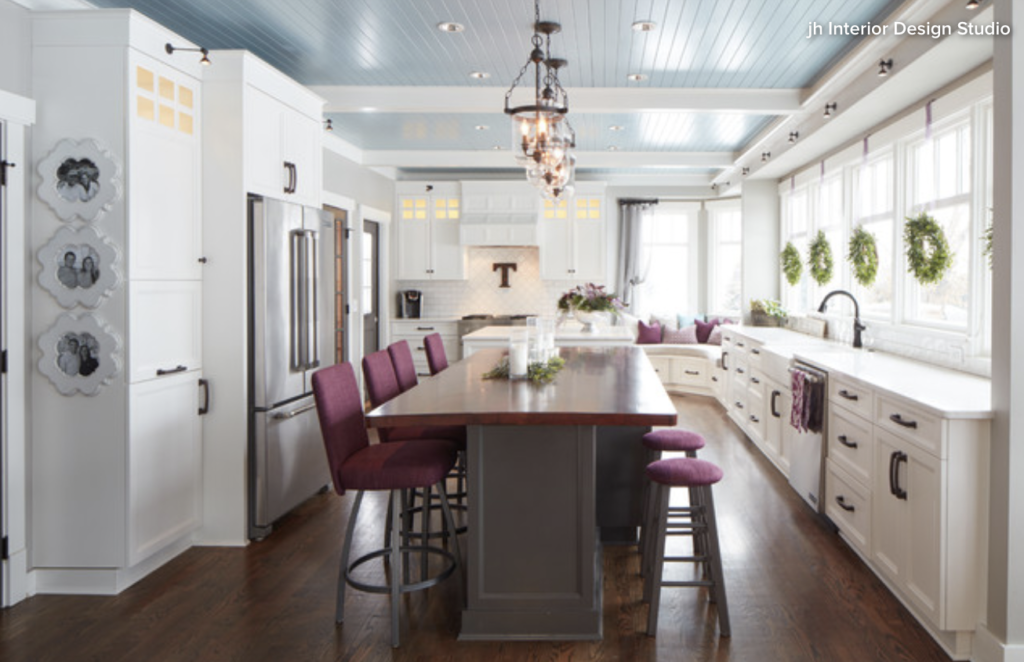
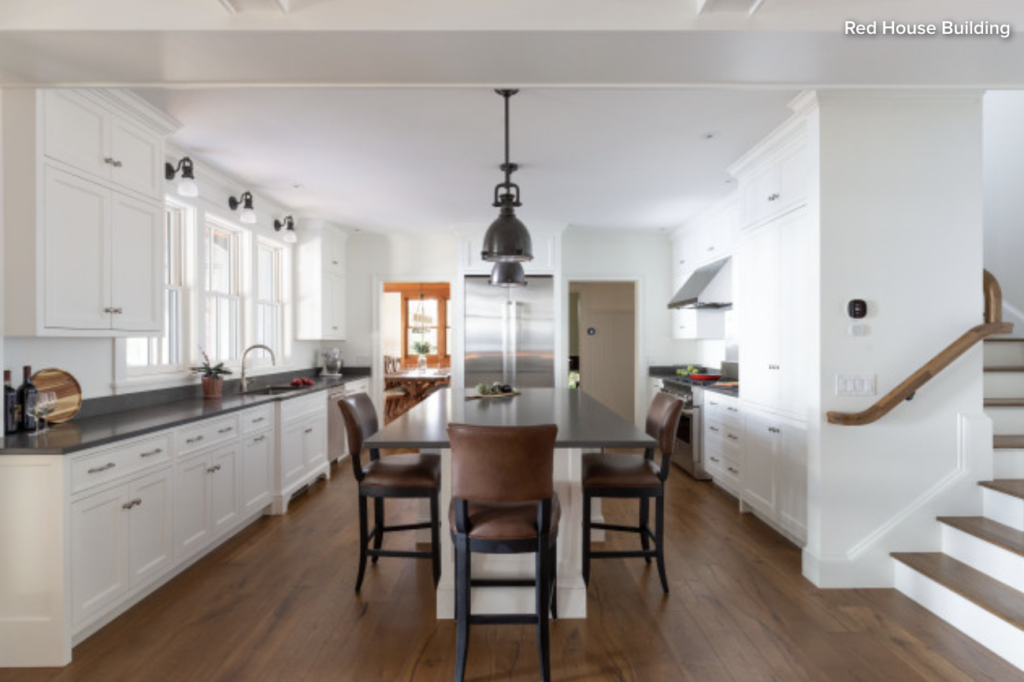
Three-Side Seating
Generally, fitting seats on three sides of the island requires a large kitchen. However, there are multiple configurations that can work for different layouts.

In this example, the island is fairly square, with a rectangular dining zone taking up half of its deep depth. This gives enough room for just one seat on two of the sides, but that is enough to allow two to four guests to converse easily.
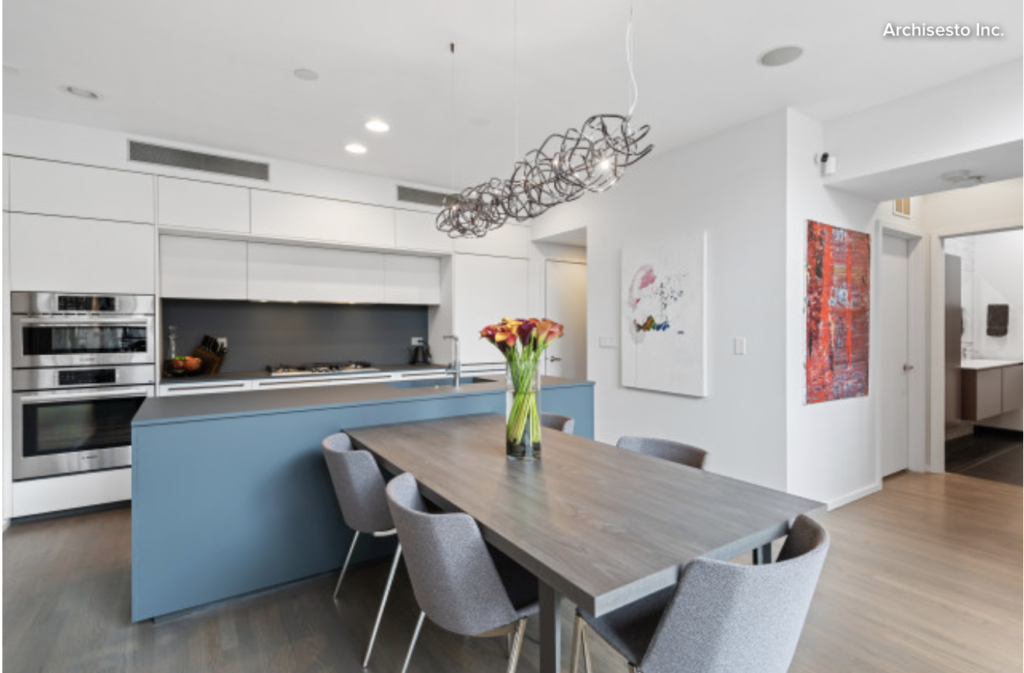
Another option is to extend a dining area out from the island to create a T shape as seen here. This essentially butts a full table up against the island, for plenty of seating for six or even more.
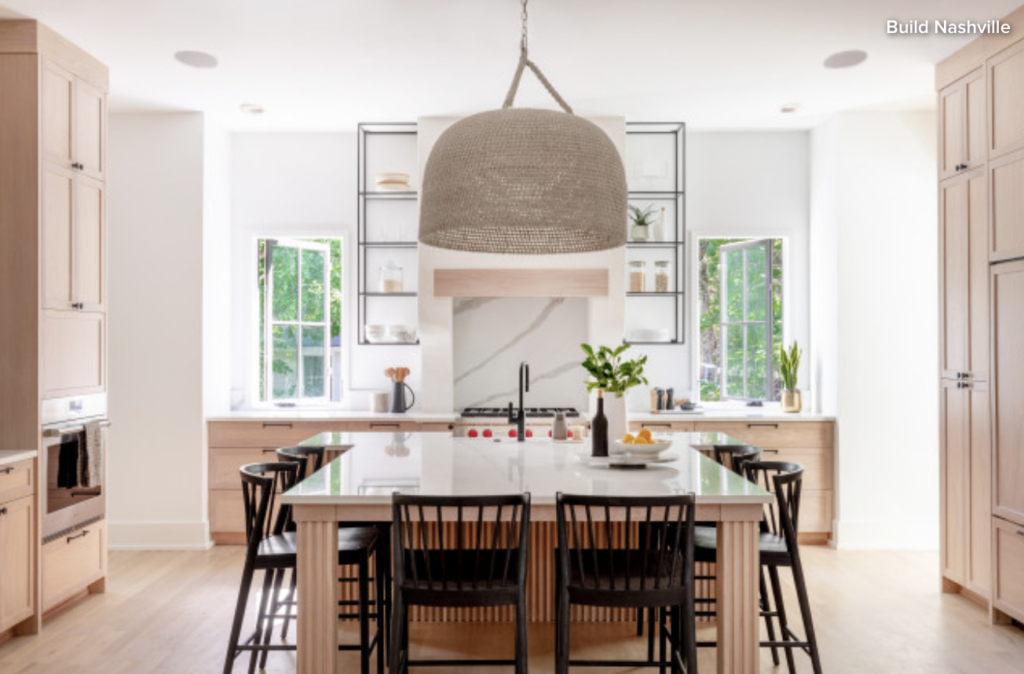
Compared with having a stand-alone table away from the island, this takes up less floor area because you don’t have circulation space between the island and table. Of course, the trade-off is the table has only three useable sides.
In an average-size kitchen, the decision often comes down to whether you want a more casual or more formal experience. For casual dining, this is a great solution that keeps the chef in on the action.
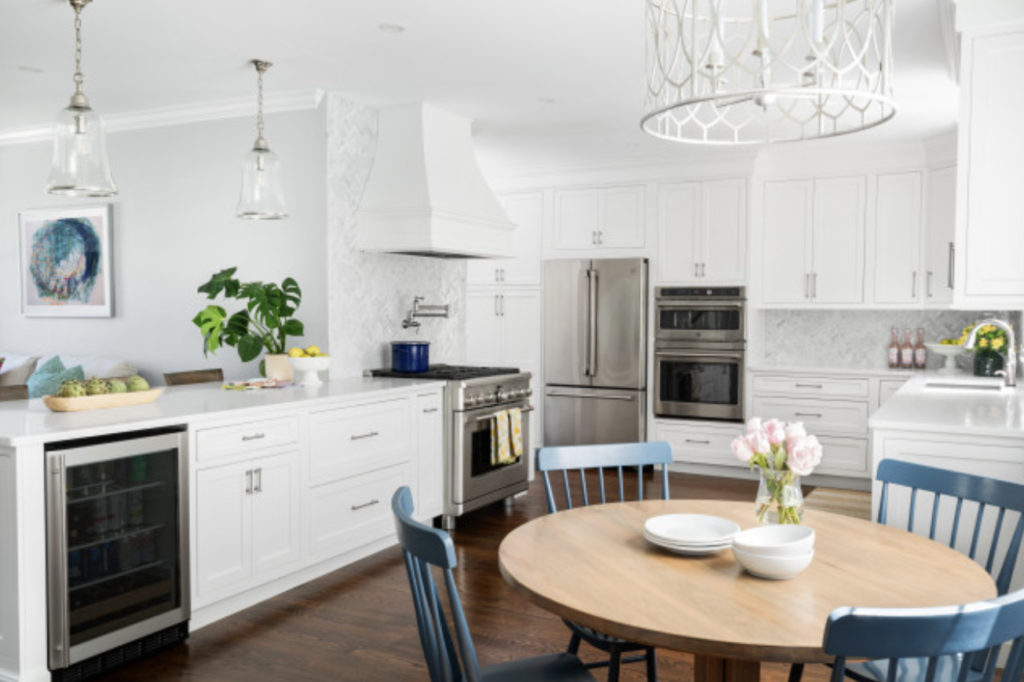
Four-Side Seating
Lastly, there is the option of skipping the proper island all together and using a dining table as an island instead. This gives up the storage space of an island cabinet but still provides an extra surface for prep work while cooking and obviously a dining space once the meal is ready.
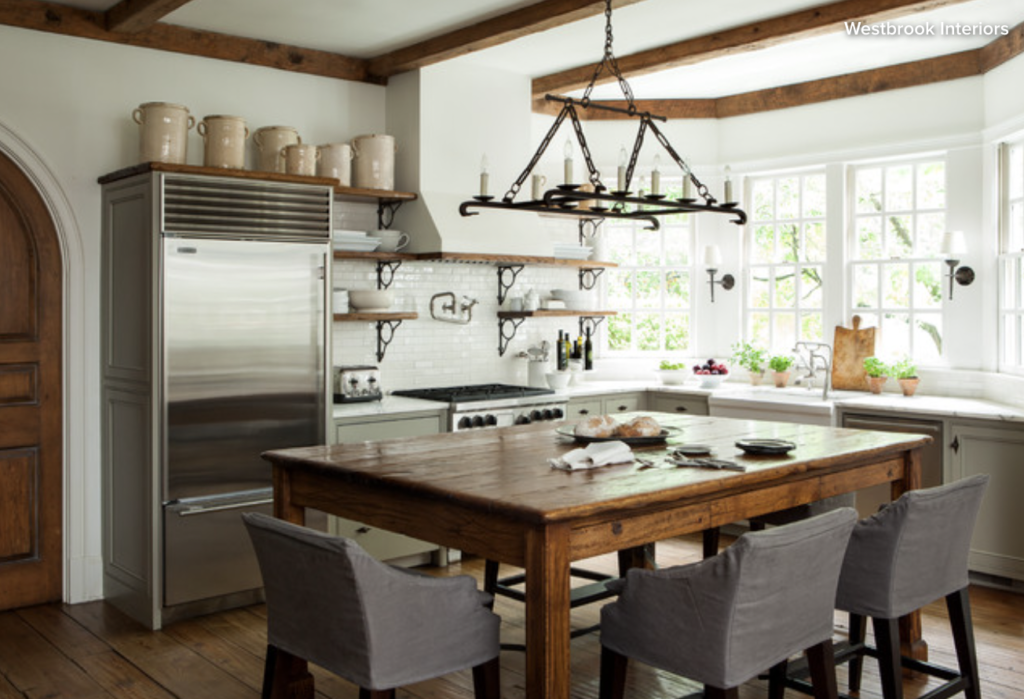
If you use a bar height table, it can easily double as a workspace. However, it will be extra important to use seats that tuck up against or under the table so the surface is easy to reach.
Seating With Arms
If you have a narrow island, seats with arms will provide a more comfortable dining experience. At the same time, arms generally take up more space and often won’t tuck under as easily. If you hope to use stools with arms, plan for each guest to have 28 to 32 inches of width instead.
Carefully consider whether you have the space for roomy stools with arms. If you do, consider it an investment in many comfortable meals at your wonderful dining island.
Stay connected with all the latest trends in Kitchen & Bath! Sign up for our FREE Granite Buyers Club